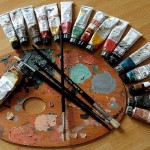Is Judaism suffocating for artists? – Ask the Rabbi
Q. An artist friend says Judaism is too suffocating for him and one can’t be a Jewish artist unless he is free. What do you think?
 A. The full text of your question explains that your friend feels he needs to be free enough to weave his way in and out of Jewish commitment in order to feel the whole range of Jewish emotion and identity. He tells you that writers too have this problem and that if a Jewish artist of any kind does not depict Jews and Jewish life in a conventional way the community wants to disown them.
A. The full text of your question explains that your friend feels he needs to be free enough to weave his way in and out of Jewish commitment in order to feel the whole range of Jewish emotion and identity. He tells you that writers too have this problem and that if a Jewish artist of any kind does not depict Jews and Jewish life in a conventional way the community wants to disown them.
In commenting on these views let me say that there I see the problem as having two aspects – the subject matter and the way it is depicted. Having a good knowledge of Jewish subjects equips the artist with fascinating material and an insight into how Jews relate to it. I have squirmed to see or read the works of Jewish artists who, for example, make glaring mistakes as to what goes on a Seder table or what Kol Nidrei says. This is inexcusable when it is so easy to check the facts.
However, what an artist sees in the material, how it speaks to them, and how they express it is largely a personal judgment which cannot be dictated or constrained by community machers. Nor is it appropriate to expect an artist to be merely a photographer and to cleanse his or her artistic lens of every shred of imagery or imagination (though much could be said, but I resist the temptation to do it here, about the sheer untruth of the common assertion, “the camera does not lie”).
No-one could impose fetters on a non-photographer like Chagall, for instance, who produced works of fantasy and whimsy which sometimes have an oddness about them. Just as the artist claims the right to be free, so must the audience be free to be excited or repelled by a work of art, or even to feel insulted.
To take the example of Chagall again, he sometimes portrayed the Jewish tragedy in the form of a crucified Jesus wrapped in a tallit. Certain Jewish critics accused him of blurring the distinctions between Judaism and Christianity; others found it a powerful image of pain and injustice. Chagall was probably the most Jewish of artists because he worked with and through the Jewish soul. It would have made a worse artist out of him if he had been an artistic mercenary who had to do exactly what his patrons specified.
True artists cannot sell their soul for what the Bible calls “a mess of pottage” (Gen. 25:29-34) or be och’lei shulchan Izevel – “eaters at Jezebel’s table” (I Kings 18:19). Very few artists get a commission to produce a work that is “warts and all”, to use a phrase attributed to Oliver Cromwell, who wanted “all these roughnesses, pimples, warts, and everything as you see me”, but even that would not guarantee a problem-free commission.



